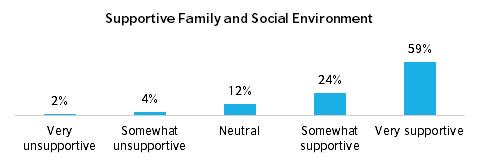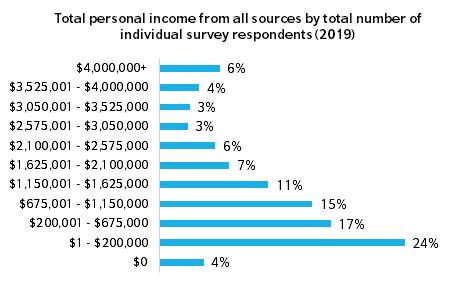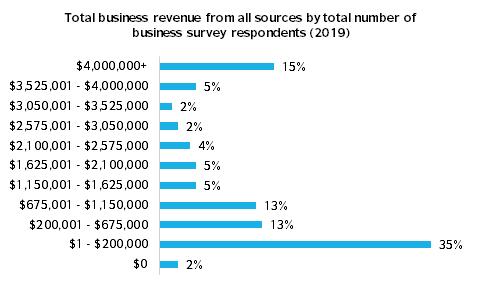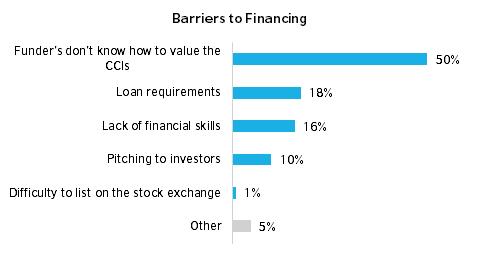
20 minute read
5. Opportunities and Challenges
Understanding Jamaica’s cultural and creative industries is critical for unlocking the sector’s potential. Data, information, and analysis can help improve decision-making by industry and government, and can raise the understanding of the cultural, social, and economic value of the CCIs, paving a roadmap for the opportunities they present for all Jamaicans.
The CCIs operate as an ecosystem of interrelated actors and activities. As such, support for the sector is most effectively delivered in a holistic manner. In this way, the whole is greater than the sum of its parts, where each support would have a greater impact when implemented alongside other supports.
Advertisement
5.1 Industry support
The cultural and creative industries worldwide share challenges in obtaining support and addressing the market failures they face. When seen to be competing for the attention of public support, the CCI’s are not recognised for their social return on investment in terms of the economy, health, social justice, and education.
The Jamaican Ministry of Culture, Gender, Entertainment and Sport (MCGES) manages the Entertainment and Creative Industries Registry (E-Registry), a database that stores cultural and creative business registrations. Businesses registered through this forum are then able to access economic benefits such as productive input reliefs. MCGES encourages cultural and creative businesses to register themselves through this database to streamline their ability to access such benefits.
It is international best practices for governments and agencies to coordinate their CCI support structures. In providing a holistic approach to sector development, one intervention can have a greater impact when delivered alongside other interventions – where the whole is greater than the sum of its parts. Nordicity’s survey found that support for entrepreneurship was the top priority support sought by respondents (22%), followed by support for networking and collaboration (21%). Support for reducing import duties was a priority for 16% of respondents, followed by sector representation, advocacy and coordination (11%), encouraging private investment (8%), international export support (8%) and training (7%). Support for performance space was sought by 5% of respondents, provision of workspace was sought by 2%, whilst 10% identified other priorities of support sought including support for marketing and discoverability, media coverage, sector research and evaluation.
Source: Nordicity Survey 2020. Sample: n=505
One example of a recently-coordinated CCI support structure can be observed in Canada, with the development of Creative Saskatchewan. Founded as a public funding agency, Creative Saskatchewan supports the economic development of the cultural and creative industries by funding 14 grant forms in support of practitioners and businesses across the sectors. The agency provides a one-stop shop for the book publishing, visual arts and craft, music, film/TV, performing arts, and digital media industries. Funding is tailored to different elements of each industry value chain, and range from supporting the development of new content and ideas, the production of creative and artistic works, and engagement in market development activities such as attending international showcases, tours, and markets. These supports provide creative entrepreneurs with small capital injections to stimulate economic activity, helping them ultimately bring their creative products to market.
5.2 The value perception of the CCIs
The value perception of a sector plays a significant role in its success, particularly regarding policy formation, its talent pipeline and skilled workforce. In Jamaica, as with many other developing nations, the creative sectors are celebrated for their cathartic and entertainment benefits but underestimated for their economic and social contributions. With some exceptions like the film sector, Jamaica’s CCI’s to date have not been measured in terms of their contribution to GDP, employment, revenues and exports, and fiscal returns to government in taxes. Neither policymakers nor everyday Jamaicans are aware of the value of the CCIs, causing barriers to supportive policy environments nor supportive family and social environments.
In major global creative economies such as the UK, US and Canada, and where the CCIs have government support, the industries have been on a multi-decade journey of promoting the value perception of the industries through mapping and economic and social impact analysis. In a similar spirit, there is a need to increase the value perception of the CCIs in Jamaica. And whilst this value perception requires time and resources, there is a strong momentum and interest in Jamaica from industry and government alike.
5.3 Complete, accurate and relevant industry data
Whilst considerable progress has been made by the government through agencies such as the Jamaica Business Development Corporation and STATIN, there remains a lack of complete, accurate and relevant industry data on Jamaica’s cultural and creative industries. This lack of data has led to a limited understanding of the CCI’s scope, challenges, opportunities, and impact. It has hindered policy formation and strategy implementation for the sector as neither government nor industry have the data and information required for evidence-based decision-making. As a result, many industry practitioners have had to forge their own path, without sufficient foresight, information, and support.
5.4 Connecting the dots, coordinating the fragmented CCIs, and a unified voice
The industry has an abundance of creatives, enterprises and support bodies disaggregated across a myriad of sub-sectors, genres and communities. Whilst this fragmentation is natural for organic grassrootsled creative sectors, it also presents barriers to realising the sector’s true potential. In economic terms, this fragmentation has resulted in a market coordination failure, where the full market potential is not realised due to a lack of coordination in information and decision-making.
Moreover, this coordination failure has resulted in confused advocacy and communications between government and the CCIs due to the lack of a unified sector voice. And in many cases where the sectors are less formal or organised, they may not have an opportunity to be heard at all.
In the world-leading markets for the CCIs, the sectors have connected the dots, coordinated themselves and established a unified voice through strong industry associations, governance structures, advocacy, and capacity building. In this way there is a need to coordinate the sector, leverage strengths and connect the dots.
5.5 Family Support
Despite the aforementioned challenges, many survey respondents indicated that their family was supportive of their pursuit of work in the cultural and creative industries. Whilst only 6% indicated an unsupportive family and social environment, interviews and consultations with sector stakeholders suggested that this number may be considerably higher – as the CCI’s are not universally accepted as a career choice.

Source: Nordicity Survey 2020. Figures may not sum due to rounding. Sample: n=505
5.6 The Employment Opportunity
The employment opportunity for the CCIs in Jamaica is significant. Because of their labour intensive nature, the culture and creative industries are increasingly recognised as future job creators of the world. The CCIs have the potential to create a high number of jobs in short periods of time and absorb labour from declining sectors of the economy.83 Globally, the CCIs account for 29.5 million jobs, employing 1% of the world’s active population. The top three employers in the CCIs have been identified as visual arts (7 million), books (4 million), and music (4 million).84
The CCI’s provide significant transferable skills. Moreover, the transferable skill of ‘creativity’ itself is expected to represent the types of jobs that are expected to grow most in importance over the next decade.85 Nesta found that ‘creativity is consistently identified as the most significant predictor for the likelihood of growth for an occupation between now and 2030’, while other transferable skills for growth included those highly related to the CCI’s including communication skills and team building.86
In South Korea, CCI workers have been found to be more independent, educated, and productive than the average, where the productivity of film and television workers was thought to be twice the national average.87
The CCI’s also play a role in inclusive growth and participation of underrepresented groups. UNESCO research showed that CCI sectors in Europe employed more youth than any other sector, and that women made up more than 50% of people employed in the United Kingdom’s music industry despite accounting for only 47% of the active population.88 The CCIs are therefore seen as the embodiment of occupations that drive entrepreneurial, inclusive, and sustainable development.
5.7 Inclusive and sustainable development
The CCIs are drivers of inclusive growth and sustainable development. Culture’s unique ability to be a connector presents a unique opportunity to engage people from all walks of life. Culture has been referred by the British Council as ‘The Missing Pillar’ of sustainable development, deserving of recognition alongside the three pillars of development – social, economic, and environmental.89 Indeed, culture contributes directly to many of the SDGs, including safe and sustainable cities, decent work and economic growth, reduced inequalities, the environment, promoting gender equality and peaceful and inclusive societies. UNESCO asserts culture’s role in sustainable development as a powerful driving factor when placed at the heart of its strategies. Through programmes such as the British Council’s Developing Inclusive Creative Economies (DICE) and Cultural Heritage for Inclusive Growth (CH4IG) programmes, the CCIs provide a powerful mechanism for policymakers.
The Planning Institute of Jamaica noted that, given Jamaica’s relatively large working age population, its declining child population, the effects of an aging population structure and urbanisation, “the country has the potential to reap a ‘demographic dividend’ providing appropriate investments are made in human resources for social and economic development.”90
83 Haans, ‘Expected job creation across the cultural industries: a sectoral division and its implications for cultural policy’, International Journal of
Cultural Policy, 2015. 84 UNESCO, ‘Cultural Times: The first global map of cultural and creative industries’, EY, 2015. 85 Creative Industries Policy & Evidence Centre. Creativity and the future of skills, Nesta, 2018. https://media.nesta.org.uk/documents/Creativity_ and_the_Future_of_Skills_v6.pdf 86 Ibid. 87 UNESCO, ‘Cultural Times: The first global map of cultural and creative industries’, EY, 2015. 88 Ibid. 89 Nordicity, ‘The Missing Pillar – Culture’s Contribution to the UN Sustainable Development Goals’, The British Council, 2020. https://www. britishcouncil.org/sites/default/files/the_missing_pillar.pdf 90 Planning Institute of Jamaica, ‘Economic & Social Survey Jamaica’, 2018.
5.8 Skills, Training & Education
Skills, training, and education provides a foundation for the cultural and creative industries. And as the world turns increasingly towards automation and integrating further technologies, the need for skills, training and education are poised to continue growing.
A lack of business skills was identified as a barrier to growth and sustainability by CCI entrepreneurs in this research. Many creatives in Jamaica have reported a need for enhancing their business and entrepreneurship skills. For a sector comprised of many freelancers, artist entrepreneurs and micro enterprises, financing, product pricing and negotiation skills are crucial.
For those survey respondents with a tertiary education in the CCI’s, the University of the West Indies (UWI) was attended by the most (30%), followed by 25% who attended Edna Manley College of the Visual and Performing Arts. Approx. The Vocational Training and Development Institute (VTDI) was attended by 6% of respondents, followed by The Creative Production and Training Centre (CPTC) (5%), the Caribbean School of Media and Communication (5%), and iCreate Institute at the University of the Commonwealth (4%). Meanwhile, just under a quarter of respondents (24%) attended other institutions including the Caribbean School of Architecture, Excelsior, HEART, University of East London, University of London, and the University of Technology (UTECH) amongst others.
Source: Nordicity Survey 2020. Sample: n=495

The CCI’s in Jamaica face several barriers to skills development. Affordability was the biggest barrier to obtaining training, education and advancing skills, reported by 30% of survey respondents as the biggest barrier to development. Other barriers included a lack of training/education nearby (14%), followed by the competitiveness of being accepted to an institution (10%), and lack of family support (7%). Meanwhile, 39% of survey respondents did not identify any barriers to training, education and skills.

There is a significant appetite to enhance the skills and talent pipeline in Jamaica’s CCIs. The most promising opportunity for survey respondents was increasing awareness of skills opportunities and resources, followed by increasing arts education in schools (21%). The provision of short-term training was sought by 9% of survey respondents, followed by access to mentors and role models (8%), the provision of more long-term training programmes (8%), support for training overseas (7%), and access to on-the-job training (6%).
Meanwhile, 9% of respondents suggested other opportunities for enhancing the skills and talent pipeline including enhancing the education system and supporting teachers with arts curriculum, updating training curriculum, exploring more practical means of training and education, and better links between education and the cultural and creative industries.

Source: Nordicity Survey 2020. Sample: n=508
5.9 Market Development and Business Growth
The market development and business growth potential of the CCI’s in Jamaica is significant. The sector is comprised of many individual creators and freelancers, alongside a large gig economy. There is an appetite to develop the sector’s entrepreneurial and business skills to unlock this growth potential.
Industry income and revenue
A majority of survey respondents earned personal incomes below JMD $1.15 million per year, with nearly a quarter earning between JMD $1-200,000 (24%) and 4% reporting zero income at all. This reinforces interview findings that the work of cultural and creative entrepreneurs tends to be undervalued, impacting the ability for practitioners in these sectors to make a sufficient living. Meanwhile, another quarter earned between JMD $1.2m-2.6m, and 16% earned more than JMD $2.6m, suggesting that some practitioners were able to achieve considerable earnings from all of their work activities. It is worth noting that this question asked respondents to record their income from all sources, some of which might not originate from their activities in the cultural and creative industries.

Note: JMD $ Jamaican dollars. Source: Nordicity Survey 2020. Sample: n=434
Total business revenue for the majority of survey respondents was between JMD $1 - $200,000 (35%), followed by those making above JMD $4 million (15%). This might indicate a gap between the size of businesses in Jamaica’s CCIs, with many falling into the micro and/or large scale with fewer mid-sized enterprises. This saturation of businesses’ making modest revenues further reinforces the perceived undervaluation of the cultural and creative industries in Jamaica.
Jamaica’s CCIs are primarily composed of business owners and/or individual artists as illustrated in Section 3.1, of which many describe their roles as being artists/creatives rather than business leaders. This supports the suggestions that there are a number of micro to small businesses that largely comprise Jamaica’s CCIs – potentially indicating a large individual entrepreneur and/or freelancer population who might be facing challenges in market development and growth. There is a sector demand for business support in the form of funding and training to encourage growth and sustainability in the long-term.

Note: JMD $ Jamaican dollars. Source: Nordicity Survey 2020. Sample: n=128
An overwhelming majority of Jamaica’s creative business survey respondents have earned the majority of their revenues from local sales. Just over half of respondents (54%) who own their own business indicated that 100% of their revenues came from Jamaica sales, whilst 21% have earned at least three quarters of their sales from within Jamaica. The low volume of exports suggests a need for CCI export support. A number of stakeholders consulted noted that the cost to export products can cost more than the value of the sale itself. As such, trying to reach international markets might not be a viable option for some smaller creative businesses.
Jamaica’s cultural and creative industries see opportunities for growth and revenues. The most significant opportunity for growth and revenues was considered market development and sales by nearly a third of survey respondents (31%). Improving sector skills was considered the next most significant opportunity, including business skills (21%), creative and technical skills (16%), improving knowledge of IP and copyright (8%), and digital skills (7%). Meanwhile, increasing international exports was considered the greatest opportunity by 13% of respondents, and other opportunities were considered by 5% of respondents including making more of Jamaica’s national brand globally and developing local markets and local supply chains.

Source: Nordicity Survey 2020. Sample: n=508
Jamaica’s cultural and creative industries face significant barriers to sales and business development. Addressing these barriers can improve Jamaica’s competitive advantage in market development, cited consistently with industry consultations and survey respondents. Whilst a myriad of issues were deemed important, a lack of business skills (35%) and a lack of marketing skills (31%) were considered the biggest barriers to sales and business development, followed by a lack of financial skills where stakeholders struggle with the process of securing financing (19%) and a lack of digital skills (6%). Meanwhile, 9% of respondents suggested other barriers including a lack of global market awareness, audience development and discoverability.
The Jamaica Business Development Corporation (JBDC) has provided significant market development and business growth support to small businesses and start-ups, ranging from guidance on financing and capacity building to project management and market and product development. In response to the Covid-19 pandemic, JBDC launched the weekly ‘In Concert’ capacity building programme. Featuring panel discussions from stakeholders in different CCI sectors, In Concert emerged as a CCI sector mainstay, having since grown to curating ongoing business development training workshops through a Virtual Biz Zone. These results suggest that practitioners may not yet be able to take full advantage of certain training resources, and face barriers including a lack of internet access or shortage of time, and illustrates a need to continue incorporating business skills into CCI programme curricula.

Source: Nordicity Survey 2020. Sample: n=508
Further investment in business skills and market development, with a focus on digital, would help advance the CCIs. The Jamaican cultural and creative industries seek a combination of traditional and innovative means of bringing its goods and services to market. Consultations have pointed to discoverability, digital skills, and data as crucial development areas for the sector. The biggest priority was considered digital marketing and distribution, identified by nearly half of the Nordicity survey respondents (43%). Traditional means of market development were identified by just under half of survey respondents, including physical marketing and distribution (18%), showcases (13%), trade fairs (9%) and exhibitions (7%). Meanwhile, 9% of respondents identified other means of bringing goods and services to market, including more international collaborations, co-productions, sponsorships, increasing intermediaries, distributors and wholesalers, and enhancing quality assurance, industry standards, capacity and scalability.

Source: Nordicity Survey 2020. Sample: n=508
5.10 Financing
Access to financing is a major challenge facing the growth and sustainability of Jamaica’s cultural and creative industries. A resounding challenge facing Jamaica’s creative enterprises was convincing funders and investors of the value of their work. Industry consultations reflected the views of survey respondents viewing the most significant barrier the sector faced in obtaining financing was convincing funders of the value of the sector.
The valuation of cultural and creative intellectual property (IP) was identified as the main barrier to financing by half of the survey respondents (50%). Related to this, meeting stringent or unsuitable loan requirements from lenders was considered the second most significant barrier to financing, identified by nearly one fifth of survey respondents (18%). A lack of financial skills was deemed the third most significant barrier to financing, identified by 16% of respondents, followed by business pitching to investors (10%). Meanwhile, the Planning Institute of Jamaica reports the stock of ‘Loans and Advances to the Entertainment Industry at Commercial Banks fell by JMD $1,890 million to JMD $2,491 million.91
Approx. 5% of survey respondents indicated other challenges included a lack of business and entrepreneurship skills and a disconnect between the financial sector and the cultural and creative industries. Whilst only 1% of respondents identified ‘difficulty to list on the stock exchange’ as the most significant barrier, several key informant interviews revealed this as a significant challenge, particularly for digital and technology oriented creative businesses. Meanwhile, for many cultural and creative businesses, stock exchange listing is unfamiliar and not commonly used as a mode of financing sought.
Source: Nordicity Survey 2020. Sample: n=508

A decisive finding from the industry consultations was the lack of private and public funding support for cultural and creative businesses. Many stakeholders noted that it was uncommon if not impossible to secure start-up financing and general loans from the major financial institutions in Jamaica. This may be because institutions do not know how to adequately define the value of CCI products. A lack of usable, up-to-date data for these sectors has exacerbated their inability to properly value their IP assets and leveraging IP value capture.92
91 Planning Institute of Jamaica, ‘Economic & Social Survey Jamaica’, 2018 92 Nurse. ‘IP value capture: fostering trade by capturing the value of creative industries in developing countries’, WIPO Magazine, 2018, https://www. wipo.int/wipo_magazine/en/2018/si/article_0001.html.
5.11 SWOT Analysis
Based on a review of data and insights gleaned from key informant interviews and the results of the national CCI survey, a series of strengths, weaknesses, opportunities, and threats were identified characterizing Jamaica’s cultural and creative industries.
Strengths Weaknesses
• Storied indigenous local creative sector ecosystem (e.g., film, digital media, Gifts & Crafts, Fashion) • Many government agencies and bodies tasked with supporting different parts of the ecosystem (e.g., IP protection through JIPO, capacity building through the
JBDC). • An abundance of creative talent • A highly collaborative sector, supportive of partnerships and co-productions • Disaggregated value chain (reliance on imports)
• Fragmented representation at government level (i.e., parts of the CCI value chain covered at different government ministries, making communications confusing and timely) • Import barriers and tariffs (Tools of Trade) • Constraints of global stereotyping of Jamaican culture
• Kingston designated a UNESCO Creative City of Music. • Limited sector data, monitoring and evaluation • Multiple locations across the island have been • Limited financing available to entrepreneurs in the awarded UNESCO heritage designations – signaling CCIs the strength of Jamaica as a cultural heritage location. • English-language and cultural resonance globally • Private financing/investment lacks understanding of value of CCIs
• Global demand and appreciation for Jamaican and
Caribbean culture • Introductory film sector incentives (tax reliefs), and the decision to create a Film Fund • Increased sector support and representation at institutional levels • Strong diaspora community which advocates on behalf of the Jamaican cultural sector • Limited local market and distribution channels for CCI products • Shortage of flagship cultural and creative enterprises (anchor companies) • Lack of business services tailored to CCIs (e.g., accounting) • Lack of market coordination
• Underdeveloped business culture and international standards • Devaluing of artistic/creative work by locals common
Opportunities Threats
• Enhancing the IP regime and national revenues • Supply chain disruptions (domestic and international) • Negotiate with foreign trade partners to further IP • Related industries face challenges (e.g. decrease in protection, set up co-production treaties and build tourism) trade deals. • Increase domestic/indigenous production and market • Erosion of the value of Jamaican culture • Use culture as a means for economic development • Loss of Jamaican cultural heritage (techniques, and inclusive growth tradition and culture) • Create an ecosystem that supports innovation and • International competition, facilitated by inbound expansion beyond existing cultural successes (global culture online expectations / stereotypes) • Develop economic impact assessment of Jamaica’s • IP misuse (e.g. theft)
CCIs • Develop a national CCI strategy with input for local • Erosion of Jamaican industry infrastructure (e.g. to stakeholders global or digital infrastructure / powers) • International collaboration and production (e.g., • Lack of innovation partnerships, co-investment, co-production treaties) • Digital production, distribution, and consumption • Lack of commercialization • Enhance “Brand Jamaica” to include a wider variety of • Barriers to international mobility of people, goods, and cultural products services • Create a national campaign to encourage funders/ corporate businesses to understand the value of creative products.






